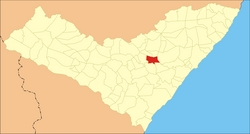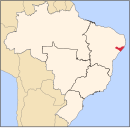.mw-parser-output .hidden-begin{box-sizing:border-box;width:100%;padding:5px;border:none;font-size:95%}.mw-parser-output .hidden-title{font-weight:bold;line-height:1.6;text-align:left}.mw-parser-output .hidden-content{text-align:left}You can help expand this article with text translated from
the corresponding article in Portuguese. (September 2023) Click [show] for important translation instructions.
Machine translation, like
DeepL or
Google Translate, is a useful starting point for translations, but translators must revise errors as necessary and confirm that the translation is accurate, rather than simply copy-pasting machine-translated text into the English Wikipedia.
Consider
adding a topic to this template: there are already 1,522 articles in the
main category, and specifying|topic= will aid in categorization.
Do not translate text that appears unreliable or low-quality. If possible, verify the text with references provided in the foreign-language article.
You must provide
copyright attribution in the
edit summary accompanying your translation by providing an
interlanguage link to the source of your translation. A model attribution edit summary is Content in this edit is translated from the existing Portuguese Wikipedia article at [[:pt:Maribondo]]; see its history for attribution.
You should also add the template ((Translated|pt|Maribondo)) to the
talk page.
For more guidance, see
Wikipedia:Translation.
Place
Maribondo |
|---|
 |
| Established | 24 August 1962 |
|---|
|
| • Total | 171.279 km2 (66.131 sq mi) |
|---|
|
| • Total | 13,193 |
|---|
| • Density | 77/km2 (200/sq mi) |
|---|
09°34′37″S 36°18′18″W / 9.57694°S 36.30500°W / -9.57694; -36.30500
Maribondo is a municipality located in the Brazilian state of Alagoas. Its population is 13,193 (2020)[1] and its area is 171 km2.[2]
History
Small place called Poço da Caatinga was established in 1905, 18 kilometers away from Anadia, and had this name for having a well of clear water located between Inga and Cassia fistula trees. In the middle of the vegetation a large house of Wasps (maribondos) was formed, and the place became called Poço da Casa de Maribondos. Among farms, José Sapucaia de Araújo's was the one that developed the most, with the installation of the first cotton steamer in 1910. In 1913, the Azevedo family arrived in the region and, soon after, José Xavier de Azevedo installed the first fair, destroyed by the Anadia municipal guard.
The history of the town recognizes as its founder João Antônio dos Santos, who bought a large farm in 1919, building a house and the first grocery store in the town, opening also a small fabric store.
In 1930, with 45 residents, Maribondo served as a rest stop for travelers coming to the capital or going to the interior. In 1947 a new fair was established. Governor Silvestre Péricles, created the Rural School in 1948, and the first church in 1950. The BR-316 highway also gave an important boost to the development of the town, leading a group to work for autonomy. In 1962, the district was emancipated from Anadia.[3]

